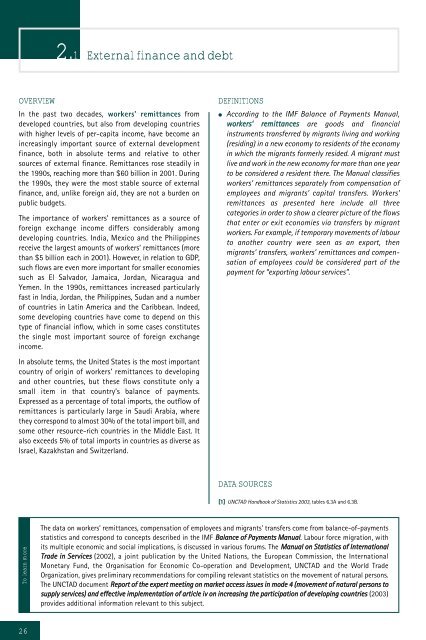Development and Globalization: - Unctad
Development and Globalization: - Unctad
Development and Globalization: - Unctad
Create successful ePaper yourself
Turn your PDF publications into a flip-book with our unique Google optimized e-Paper software.
26<br />
2.1 External finance <strong>and</strong> debt<br />
OVERVIEW DEFINITIONS<br />
In the past two decades, workers’ remittances from<br />
developed countries, but also from developing countries<br />
with higher levels of per-capita income, have become an<br />
increasingly important source of external development<br />
finance, both in absolute terms <strong>and</strong> relative to other<br />
sources of external finance. Remittances rose steadily in<br />
the 1990s, reaching more than $60 billion in 2001. During<br />
the 1990s, they were the most stable source of external<br />
finance, <strong>and</strong>, unlike foreign aid, they are not a burden on<br />
public budgets.<br />
The importance of workers’ remittances as a source of<br />
foreign exchange income differs considerably among<br />
developing countries. India, Mexico <strong>and</strong> the Philippines<br />
receive the largest amounts of workers’ remittances (more<br />
than $5 billion each in 2001). However, in relation to GDP,<br />
such flows are even more important for smaller economies<br />
such as El Salvador, Jamaica, Jordan, Nicaragua <strong>and</strong><br />
Yemen. In the 1990s, remittances increased particularly<br />
fast in India, Jordan, the Philippines, Sudan <strong>and</strong> a number<br />
of countries in Latin America <strong>and</strong> the Caribbean. Indeed,<br />
some developing countries have come to depend on this<br />
type of financial inflow, which in some cases constitutes<br />
the single most important source of foreign exchange<br />
income.<br />
In absolute terms, the United States is the most important<br />
country of origin of workers’ remittances to developing<br />
<strong>and</strong> other countries, but these flows constitute only a<br />
small item in that country’s balance of payments.<br />
Expressed as a percentage of total imports, the outflow of<br />
remittances is particularly large in Saudi Arabia, where<br />
they correspond to almost 30% of the total import bill, <strong>and</strong><br />
some other resource-rich countries in the Middle East. It<br />
also exceeds 5% of total imports in countries as diverse as<br />
Israel, Kazakhstan <strong>and</strong> Switzerl<strong>and</strong>.<br />
To learn more<br />
● According to the IMF Balance of Payments Manual,<br />
workers’ remittances are goods <strong>and</strong> financial<br />
instruments transferred by migrants living <strong>and</strong> working<br />
(residing) in a new economy to residents of the economy<br />
in which the migrants formerly resided. A migrant must<br />
live <strong>and</strong> work in the new economy for more than one year<br />
to be considered a resident there. The Manual classifies<br />
workers’ remittances separately from compensation of<br />
employees <strong>and</strong> migrants’ capital transfers. Workers’<br />
remittances as presented here include all three<br />
categories in order to show a clearer picture of the flows<br />
that enter or exit economies via transfers by migrant<br />
workers. For example, if temporary movements of labour<br />
to another country were seen as an export, then<br />
migrants’ transfers, workers’ remittances <strong>and</strong> compensation<br />
of employees could be considered part of the<br />
payment for “exporting labour services”.<br />
DATA SOURCES<br />
[1] UNCTAD H<strong>and</strong>book of Statistics 2003, tables 6.3A <strong>and</strong> 6.3B.<br />
The data on workers’ remittances, compensation of employees <strong>and</strong> migrants’ transfers come from balance-of-payments<br />
statistics <strong>and</strong> correspond to concepts described in the IMF Balance of Payments Manual. Labour force migration, with<br />
its multiple economic <strong>and</strong> social implications, is discussed in various forums. The Manual on Statistics of International<br />
Trade in Services (2002), a joint publication by the United Nations, the European Commission, the International<br />
Monetary Fund, the Organisation for Economic Co-operation <strong>and</strong> <strong>Development</strong>, UNCTAD <strong>and</strong> the World Trade<br />
Organization, gives preliminary recommendations for compiling relevant statistics on the movement of natural persons.<br />
The UNCTAD document Report of the expert meeting on market access issues in mode 4 (movement of natural persons to<br />
supply services) <strong>and</strong> effective implementation of article iv on increasing the participation of developing countries (2003)<br />
provides additional information relevant to this subject.

















